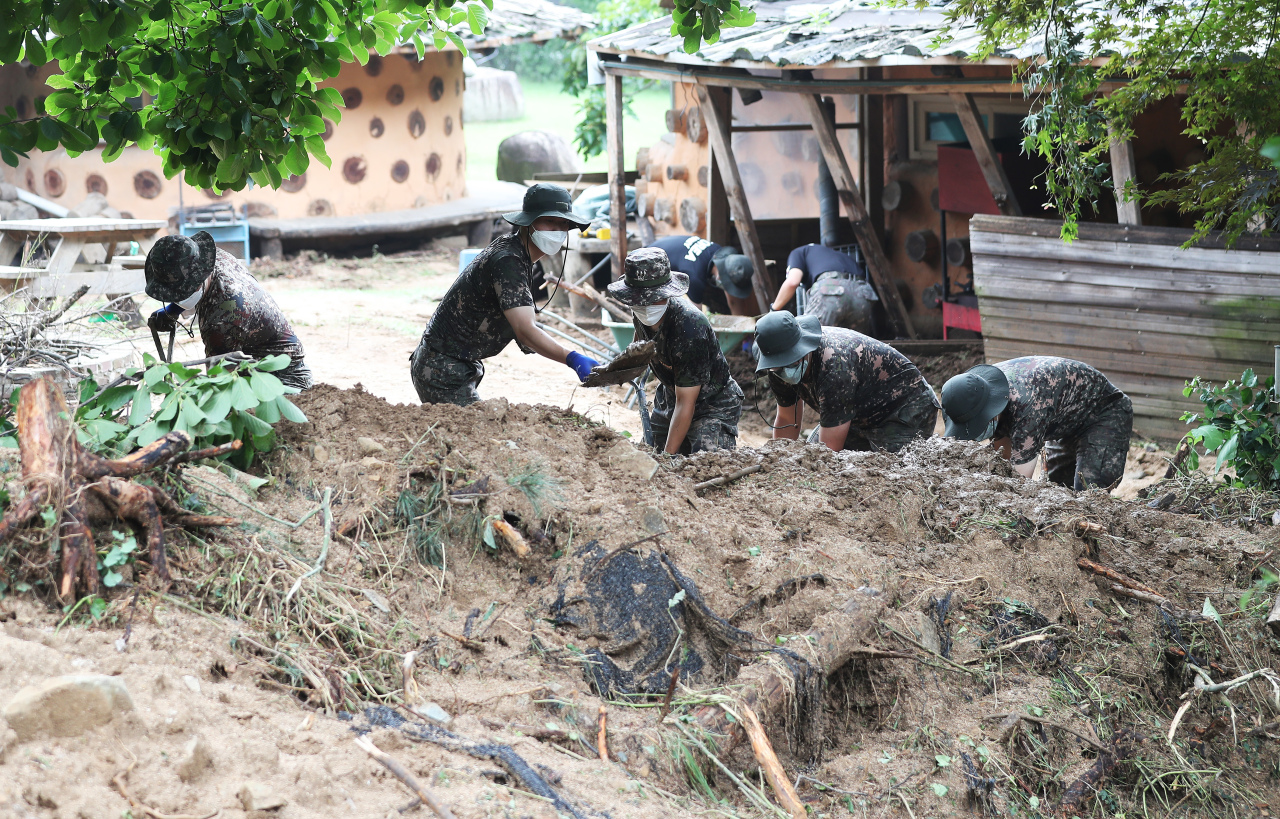 |
Military service members are at work in Anseong, Gyeonggi Province, on Tuesday to clear the mud piled up from heavy downpour that started over the weekend. (Yonhap) |
Damage and casualties continued to rise Tuesay, as a heavy downpour that started over the weekend extended to a fourth day.
By 4 p.m. Tuesday, the torrential rains in capital Seoul and provinces Gyeonggi, North Chungcheong, South Chungcheong and Gangwon had left 14 dead, 12 missing, and seven injured, according to the Central Disaster and Safety Countermeasure Headquarters.
A man who went missing in a manhole Monday was found dead Tuesday morning and another man was found dead in Gapyeong, raising the previous day’s aggregate death count from 12 to 14.
A total of 1,025 people from 629 households had to leave their homes, and around 5,751 hectares of farmland had been flooded. Some 196 people from 96 households have returned to their homes, while the remaining 829 people from 533 households have not.
From Saturday through Tuesday morning, a total of 2,958 property damage claims were reported. Of the total, 815 cases concerned flooded or swamped residential buildings, and 522 cases were for damage to barns and storage structures.
The heavy downpour has also damaged public infrastructure, causing officials to block damaged motorways and railroads. For the four days, 728 streets and 403 sections of railway track were reported to have been damaged.
Forty-four road sections have been blocked in Seoul and Gyeonggi, North Chungcheong and South Chungcheong provinces. Six railway sections have stopped operations.
For emergency rescue and maintenance efforts, a total of 25,352 civil workers, firefighters, police officers and volunteers have been dispatched to the disaster scenes with 2,116 units of support equipment.
From Saturday, the peninsula has been met with record-level rainfall ignited by a combination of factors. A typhoon combined with the North Pacific High and pockets of cooler, dry air moving in from the north has locked the heavy downpour over the middle and north of the country, making this year’s rainy season one of the longest on record and prompting torrential rains, the weather agency explained.
Typhoon Hagupit, which started from southeast of Taiwan as the fourth typhoon of the year, made its way to mainland China as of Tuesday morning. It is not expected to have a direct impact on the Korean Peninsula, but has prompted heavy packs of rain clouds to form in the region.
Heavy rain warnings and advisories issued at 9 a.m. Monday remained in effect for most regions including Seoul and Gyeonggi, North Chungcheong, South Chungcheong, Gangwon and North Gyeongsang provinces. As of 4 p.m. Tuesday, those regions had been hit with up to 526.5 millimeters of rain.
The government has been at work to quickly respond to further incidents, with the Ministry of the Interior and Safety escalating the alert response to level 3 from 3 p.m. Monday.
President Moon Jae-in held emergency response meetings with related officials after canceling his summer vacation plan. He urged ministries in a 2 p.m. meeting to focus on minimizing casualties before anything else.
Prime Minister Chung Sye-kyun ordered officials in a meeting to review the idea of designating areas damaged by the downpour as special disaster regions. The designation allows leeway for more support funds for economic and social recovery efforts.
The Financial Supervisory Service and the Financial Services Commission said Tuesday it will ensure those affected by the heavy downpour receive up to half of the estimated insurance payout before their damage claims are fully investigated.
By Ko Jun-tae (
ko.juntae@heraldcorp.com)








![[Today’s K-pop] Blackpink’s Jennie, Lisa invited to Coachella as solo acts](http://res.heraldm.com/phpwas/restmb_idxmake.php?idx=644&simg=/content/image/2024/11/21/20241121050099_0.jpg)